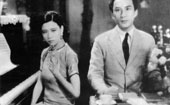
Bright Stars, Big City: Chinese Cinema’s First Golden Era, 1922-1937
at the Museum of Modern Art, New York
December 2-22, 2005
OK, this is it: I’m officially out of superlatives to describe this past season’s glut of Asian cinema offerings. So I’ll simply say, please see below my take on the four films I saw from the second exhibition of rare Chinese classics in a three-month period (see my report on the first here). Not surprisingly, there was a substantial overlap between the two series, although this one was more narrowly concentrated, focusing on the heyday of the Shanghai film industry when it was the “Hollywood of the East,” before the Japanese invasion, civil war and finally the Communist victory shifted that honor to Hong Kong. Note that most of the movies in question are silents, a form that, unlike in the West, survived in Asia well into the ‘30s.
See the complete online catalog for this series here
.

It takes a while to notice all of that, though – on a technical level, the film is the most bizarre and awkward hybrid of silent and talkie I’ve ever seen. There are Chinese intertitles, but sometimes the dialogue is redundantly spoken, and not always in sync with the actors’ lips. Meanwhile, electronic English subtitles were video-projected by the museum onto the bottom of the screen, usually a little behind or ahead of the onscreen dialogue. All of this was amidst an often incongruous music score and a torrent of superfluous sound effects. It’s an especially unfortunate example of how the brief vogue for silent/sound half-breeds could vititate the virtues of both forms.
But once I let myself get used to this mess, I found everything else pretty involving and Cai a director with a fine eye. The real engine here is Ruan, as is typical of anything I’ve seen her in. The fluidity and transparency of her face is remarkable and singlehandedly lifts New Woman to another level. She was a Midas of screen performers – everything she touched turned to gold. Whoever the bastards were who drove her to an early grave, I find it very easy to loathe them.
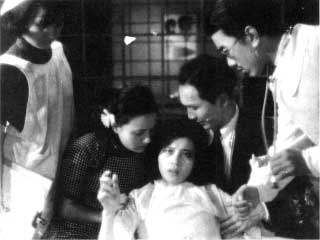
It also has the good sense to tell its ultra-spare story in a lean,
fast-paced fifty-seven minutes. That plot is nothing remarkable in
the sufferings-of-the-underclass genre – the strong acting and Cai’s aforementioned
visual sensibility carry it. I’m sorry to say I didn’t actually enjoy
it more – the museum had one of the most abominable prints I’ve ever seen
of a movie, as well as a voiceover translation of the Chinese intertitles
that was delivered in a dull and sometimes hard-to-decipher drone.
Surely the China Film Archive must have a better print somewhere of what’s
supposed to be one of the nation’s great classics.
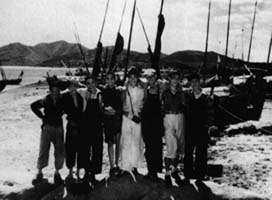
The cinematic technique, like that of much silent Chinese film I’ve seen, is at least a decade behind the West: banal, stagey blocking and visual compositions, sluggish pace with minimal editing or camera movement, barnstorming acting and way too many redundant titles explaining stuff we already know. The action (in the sense of people jumping around and hitting and slashing each other) is minimal except right at the beginning and end, and doesn’t exactly light up the screen. The most potentially interesting part of the story, during the middle third, is the title character’s martial arts training with your classic white-bearded old mentor in his mountain lair – and it takes place offscreen while the movie sleepwalks through a subplot that could have been set up in five minutes.
Perhaps I’m not plugged in to some culturally specific conceptions of
pacing, storytelling and the like, since this was apparently a hit in its
time. There’s no accounting for taste, I guess. I found little
in the way of even light amusement once I had tired of the camp value of
the garish and anachronistic costumes (check out the shiny bikinis on the
villain’s harem girls) and broken-English intertitles. You have to
be a real hardcore genre geek to even find the “historical interest” makes
it worthwhile. And even hardcore genre geek that I am, I was sighing
and fidgeting well before we got to the powerful concluding moral: “The
only roult for the Bad Ones is punishment.”
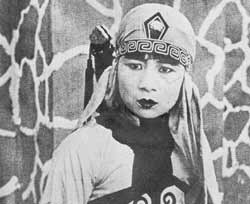
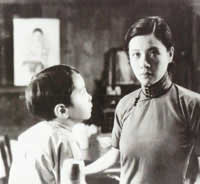
Once again, I can’t overestimate the importance of Ruan Lingyu, in probably
her most famous role, a single mother and prostitute (the title is slang
for the profession) struggling to raise her little son. Of course,
the social order, in the form of a bullying boyfriend/pimp and judgmental
neighborhood gossips and authority figures, practically makes it a duty
to see that she fails. Ruan turns in her usual, seemingly effortless
work. But she’s aided by two co-stars unusually worthy of her.
The little boy who plays her son is unforced and genuinely endearing in
a way that few child actors can manage. The big boy who plays Ruan’s
loathsome man has a potentially thankless one-note role, but assays it
with a casually vicious, “it’s a man’s world” arrogance that imparts the
chill of real-life, not movie, villainy. The two-shot confrontations
between them are striking – his bearish bulk towers over the willowy, wispy
Ruan and yet the ferocity of her body language and facial expressions almost
knocks him off the screen.
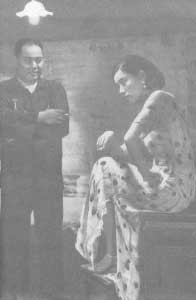
Given the exhilarating lack of equivocation in Wu’s jeremiad, it’s doubly disappointing to see a copout ending complete with benevolent, patriarchal deus ex machina. Still, try as it might, the failure of nerve in the last couple of minutes can’t do much to blunt the keen edge of all that comes before.
Michael Wells can be contacted here.